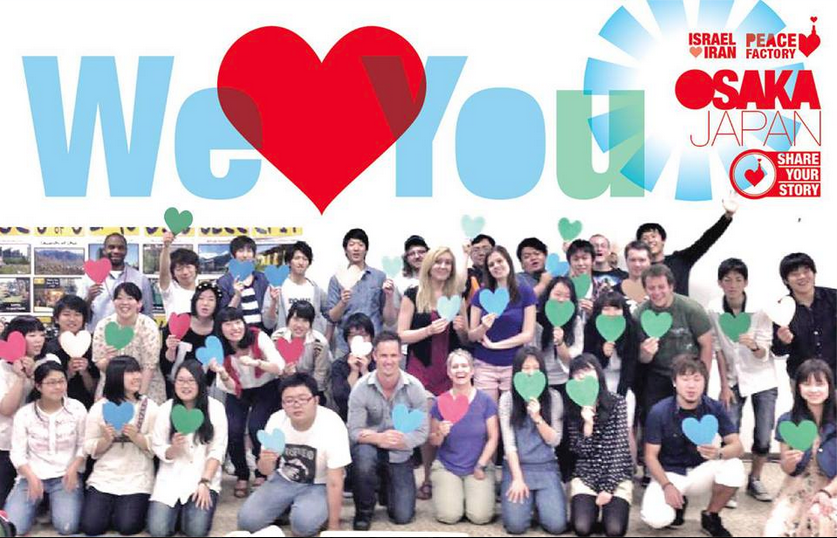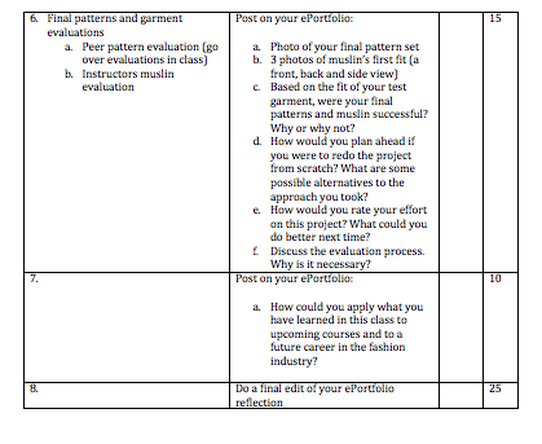Pedagogy
Faculty at SLCC have been using ePortfolios for over 10 years and have developed some great examples to help you think about how you might integrate high-impact practices with your Signature Assignments. Click on the options below for more details about each type of assignment and examples of instructions, rubrics, and other information provided to students.
David Hubert uses a Traditional Paper Reimagined As An Informative Webpage Within The Eportfolio
The assignment asks students to divide the topic into manageable sections, with each section represented on a separate page of the website. The students enjoy creating an informative webpage instead of a traditional paper. They can much more readily employ multimedia in their work, and yet they still have to do the kind of research and writing I would normally expect in a formal paper.
The grading rubric --which I share with the students in the syllabus--encourages students to
- use quantitative data in the informative website,
- mix headings, text, images and quantitative data, and
- develop the major political concepts, personalities, or events needed to give a complete treatment of the topic.
Reflection Prompts --I am currently not asking students to reflect specifically about this assignment. Instead, I have two reflection prompts that are about the course in general.
Choose from one of the following topics on which to reflect:
- Connect what you learned in this class with what you learned in other courses you have taken at SLCC or before. Be specific, as generic platitudes are not going to convince your professor. The connections might be directly related to subject knowledge, or they might be more related to concepts and processes, or they might be otherwise unrelated issues or learning between which YOU found a connection.
- Examine the General Education learning outcomes at the end of the syllabus. While no course is expected to help students achieve all of those outcomes, individual courses are supposed to provide students with opportunities to move toward achieving as many of those outcomes as make sense in a given course's context. Make specific references toward your work in this course and how it indicates you are making progress toward at least three important Gen Ed outcomes.
Student Work --Here are some example of student work on this assignment.
- Susanna Keyes' work on The Arab Spring .
INFORMATIVE WEBPAGE ASSIGNMENT FOR INTRODUCTION TO INTERNATIONAL RELATIONS
Informative Webpage-- For this assignment, you need to write a 5-6 section webpage on your course page for POLS 2100. The goal of your webpage is to inform an educated audience about your topic. It must rely on credible sources (no Wikipedia, no "Joe-Bob's Website) that are properly cited. I don't care if your citations are MLA, APA, footnotes, or endnotes. Don't let your sources take over your webpage: I want to hear your brain thinking when I read it, with quotes and data being used to support your writing rather than taking the place of your writing. Your informative webpage should be written in third person—no "I think this" and "I argue that"—and should be written professionally for an educated audience. Take a good look at the informative webpage scoring rubric at the end of this syllabus, because that is what I'll be using to grade your memo. When you have completed two sections of your webpage, I encourage you to send me the link via the Canvas messaging system, and I'll give you some feedback on how it's progressing.
Since I like directing students with respect to topics, but I also get tired of reading more than five webpages on the same topic, I will hold a first-come-first-served lottery in the second week of the course. Expect an all-class announcement at that time in which I solicit the top three topics you'd like to choose. The earliest responders are more likely to get one of their top choices. (See, it pays to pay attention in life.) These are the only possible topics for informative webpages this semester, so be thinking about them in anticipation of the second-week announcement:
- Climate Change —I would suggest a webpage with the following sections: Background and History of Climate Change; International Inaction on Climate Change (Describing the history of weak international agreements/treaties); Climate Change as a Threat Multiplier (Which is how the U.S. military is looking at it); Public Opinion on Climate Change (Document public awareness and opinion on the issue); Addressing Climate Change (What are the most promising developments for reducing greenhouse gas emissions?)
- The Global Arms Trade —Possible sections for your webpage: The Size and Scope of the Global Arms Trade; The U.S. as a Leading Arms Merchant; Fueling Conflicts with Arms (Highlighting some conflicts that continue because of imported arms); The Domestic Politics of the Arms Trade (What factors and political relationships in the arms supplying countries drive the continued trade in weapons?)
- Global Food Crisis —Some sections you might want to have in your webpage: A Look at Global Hunger (Where are the places where food shortages are most acute and what are the effects thereof?); The Food Crisis of 2008 (What was it? What were its political effects?); Factors Driving the Food Crisis (What are the general causes of the food crisis?); Addressing Food Insecurity (What are nation-states and international organizations doing to combat the food crisis?)
- The Millennium Development Goals —Possible sections for your webpage: What are the Millennium Development Goals? (background, history, list of the goals, etc.); One page for each of the seven goals (skip the one on Global Partnership) in which you describe the goal in more detail and write about what is being done to address the goal and what kind of progress is being made.
- Is Globalization Coming to an End? — Possible sections for your site: Brief History of Globalization; Globalization Depends on Cheap Fuel Prices; Globalization Depends on Economic Growth; Globalization and Ecological Limits; Globalization in Reverse (What would the economic effects be of a reversal in globalization?). I strongly suggest the following resources: Jeff Rubin, Your World is About to Get a Whole Lot Smaller. Oil and the End of Globalization (2009); Jeff Rubin, The End of Growth (2012); Richard Heinberg, The End of Growth. Adapting to Our New Economic Reality (2011); Donella Meadows, Limits to Growth: The 30-Year Update (2004); and this piece about airline travel http://www.energybulletin.net/stories/2012-08-18/running-empty-big-airlines-big-trouble .
- The Arab Spring —You might consider these sections in your informative website: Overview of the Arab Spring; Causes of the Arab Spring; Case Study—Tunisia; Case Study—Egypt; Case Study—Syria; The Arab Spring and U.S. Foreign Policy.
- The Drug War in Mexico —I would suggest the following sections for your website: Background and History of the Drug War in Mexico; Violence in the Border Area; Causes of the Mexican Drug War; U.S. and Mexican Responses to the Drug War.
- Resource Wars —Some possible sections of your webpage would be: Limited Resources in the 21st Century (in which you outline the vital resources that nation-states might want to fight over); Oil in the Middle East; Oil in East Asia; Oil in the Arctic; Water Conflicts; Farmland in Africa. You must acquire the work of Michael T. Klare, particularly The Race for What's Left (2012), but there are many sources for this topic
Kati Lewis’ Portfolio Project Transformed Into A Group Online Magazine
After a few semesters of assigning this project, I felt like this project could further evolve. My colleague, Professor Lisa Bickmore, felt the same way about portfolio projects in her 2010 course. Together, we adapted the individual online magazine project into a group project and the results are rather incredible.
Click on the image below to experience details of the Group Online Magazine project.
Note: the reflection prompts are included in the description.
LEARNING OUTCOMES ACHIEVED THROUGH MAGAZINE PROJECT
Students think critically and creatively. This includes reasoning effectively from available evidence; demonstrating effective problem solving; engaging in creative thinking, expression, and application; Engaging in reflective thinking and expression; Demonstrating higher-order skills such as analysis, synthesis, and evaluation; Making connections across disciplines; Applying scientific methods to the inquiry process.
Students develop the knowledge and skills to be civically engaged. This includes understanding the natural, political, historical, social, and economic underpinnings of the local, national, and global communities to which they belong; Developing the awareness of both civil rights and civil responsibilities for individual and collective action in a democracy; Engaging in service-learning for community building and an enhanced academic experience; Develop the knowledge and skills to take leadership roles.
Students develop computer and information literacy. This includes using contemporary computer hardware and software to effectively complete college-level assignments; Gathering and analyzing information using technology, library resources, and other modalities; Understanding and acting upon ethical and security principles with respect to computer technology and to information acquisition and distribution; distinguishing between credible and non-credible sources of information, and using the former in their work in an appropriately documented fashion.
Students develop the knowledge and skills to work with others in a professional and constructive manner. This includes engaging with a diverse set of others to produce professional work; Interacting competently across cultures; understanding and appreciating human differences; Understanding and acting on standards of professionalism and civility, including the SLCC Student Code of Conduct.
Melissa Seaboch’s Culture And The Human Experience (Anth 1010) Service Learning: Journals And Reflection

Directive : Students will engage in a minimum of 12 hours of service with a culturally diverse population. Ideally, these hours should be spread evenly throughout the semester. The choice of community partner is up to the student, but must be selected from the list below:
- Utah Association for Intellectual Disabilities
- Asian Association of Utah
- City of South Salt Lake After School Programs
- Alpha Home Health and Hospice
- Homeless Youth Resource Center
- Neighborhood House
- Crossroads Urban Center
- Guadalupe School
- Five Parks Community Action Center
- Sunnyvale Neighborhood Center
- Splore
- Sunday Anderson Westside Senior Center
- YMCA
- Utah Pride Center
Some partners on the list have evening and weekend availability; contact me if you need to know which ones. The community partner selected should include a population about which you have pre-conceived notions or that makes you uncomfortable. You should select your community partner the first week of class, make contact the second week of class, and complete the partnership agreement and begin service the third week of class. Twelve reflective journal entries, five short assignments, and a final multimedia project will be the basis of the assessment for the service learning experience.
Journal Entries
Twelve dated journal entries are required before and during the service activity. Each journal entry should be dated and 2-3 paragraphs in length; alternative formats (e.g. multi-media) are encouraged. The prompts are listed below and these should be included at the beginning of each journal entry. The first prompt should be addressed prior to beginning service, the second prompt should be addressed after the first day of service, and the final prompt should be addressed at the conclusion of your service. The remaining prompts can be addressed on your own schedule, but should be limited to no more than two journal entries each week. Journal entries lacking substantial content and reflection will not receive full points.
Scroll down to see the journal prompts.
Reflection Project
Create a multi-media project (e.g. video, slide show, song, poem, poster, letter, etc.) for students of the next semester reflecting on the service-learning experience. This project might include the following examination of your efforts in the course:
- What your expectations were;
- Your fears;
- Reflect on the experience itself, both positive and negative;
- How the service learning affected you;
- What you wish you had done beforehand;
- What you would do differently, tips for success;
- How successfully you addressed the learning outcomes for the course;
- Connections to other courses;
- Any other reflections that are relevant to your thinking and learning in the course.
This project should provide deep reflection on your experience and it should be engaging and creative.
You should include this project and five of your most insightful journal entries in your SLCC Gen Ed ePortfolio--they are the signature assignments for this course. Showcase the journal entries that you have selected and your reflection project in the Outside the Classroom page of your ePortfolio.
ANTH 1010 SERVICE LEARNING JOURNAL PROMPTS
Twelve journal entries are required. Traditional (e.g. hand-written responses, computer text document, etc.) and non-traditional (e.g. multi-media such as a slide presentation, audio journal, video journal, etc.) formats are encouraged. Each journal entry should be 2-3 paragraphs in length (or the equivalent if a non-traditional format is used) and should address the following prompts. Please include the prompt itself at the beginning of each journal entry. Ideally the prompts should be addressed in numbered order. There are no right or wrong journal entries. I am not looking for specific responses; however, journal entries lacking substantial content and reflection will not receive full points. Take the journaling as a chance to really think about the service learning experience, the people you are serving, the world in which we live, and yourself.
1. What are your expectations for this experience? What are your fears? What pre-conceived assumptions and biases do you have? What are you anxious about? Do you foresee any ethical issue arising and if so, what might they be? This journal entry should be completed before your first day of service.
2. What was your first impression? What was the first thing you noticed? Were you uncomfortable and if so, why? Did you experience culture shock? Who did you meet with? How did it go? This journal entry should be completed on the first day of service.
3. Define ethnocentrism. What ethnocentric thoughts have you had regarding the population you are serving? Keep in mind that ethnocentrism is a normal consequence of the enculturation process. What are your strategies for reducing ethnocentrism and practicing cultural relativity?
4. What are your reasons for selecting this particular community partner? In what ways is the population you are serving culturally different from you? What were you hoping to learn from the population you are serving? If you could start this experience over again, would choose the same community partner? Reflect on why or why not.
5. Bearing in mind aspects of culture (as identified by the chapter titles of your textbook (e.g. economics, kinship, marriage, arts, religion, etc.) what is something you learned about the culture of this population today? What are your feelings about the new information? In what ways is this culture similar to yours?
6. What are some challenges faced by this population? What are some of the underlying causes of these challenges? Do you think these challenges are caused by internal or external factors? What public needs are you fulfilling by serving this population? Have you participated in community engagement before? If so, describe your experience and if not, reflect on why you have not previously been civically engaged.
7. What is something that surprised you about this population? Why were you surprised? Describe a specific example where you practiced cultural relativity.
8. What are some of the strengths of this population? How might these strengths be used to overcome the previously identified challenges? The American Anthropological Association identifies the responsibilities of anthropologists in this order: responsibility to the people they study, to the public, to the discipline, to one's own government and to the host government. Do you feel any of these responsibilities apply to your service? How might you handle competing responsibilities?
9. Have any of your pre-conceived views of the population you are serving changed? If so, which ones? Was there a specific event that led to this change? Were you faced with any ethical dilemmas?
10. Did this course and service-learning experience motivate you to participate civically long-term? Reflect on your past journal entries – have any of your thoughts changed?
11. What was the best part of your service learning experience? What was the worst part?
12. Would you recommend service learning to other students? Why or why not? Were the course objectives met through service learning? What would you change about your service-learning experience? This journal entry should be completed after you have finished your service hours.
Maria Skelton’s Fashion 1660: pattern drafting procedures drafting a pattern signature assignment and reflection

-Demonstrate competence in completing a sloper
-Demonstrate competence using a sloper to draft a pattern
-Demonstrate an educated understanding of construction techniques and sequence for creating a garment prototype
-Demonstrate an educated understanding for fit analysis of, and application of construction corrections for, the garment sample.
-Demonstrate an understanding for and competence in creating final patterns.
ePortfolio Reflection Assignment / Details:
You will be writing a 3-5 page paper by answering the questions listed below (right column) in paragraph form. You are required to post the assigned photos you'll be taking that document the pattern drafting process. Feel free to use video, rather than (or along with) photos as part of your documenting process.
HYBRID GROUP/INDIVIDUAL PROJECT IN MATH 1040

Group Portion of the Project --Students are divided into groups and are asked to choose a research question, design a method for collecting data, analyze the results, and posting their work in their e-Portfolio. The purpose of the project is to have students collect and analyze data on the relationship between two quantitative variables, such as "Is shoe size of adult men related to height of adult men?" The students collect the data--ensuring a random sample--and put it into a table that is shared by all the students in the group.
Individual Portion of the Project --Once the data collection and sharing is completed, students move into the individual portion of the assignment. Each student writes a rather detailed report that includes descriptive statistics for each variable and correlation statistics for the two variables together. Students have to discuss the difficulties they encountered and come to a summary conclusion.
Reflection Prompts --Students post their individual report into their ePortfolio, along with their response to one of the following:
- What process did you go through to complete this assignment?
- What challenges did you face in completing the assignment? How did you address them?
- What impact did this project have on your understanding of statistics?
Learning Outcomes Touched by this Assignment --This assignment addresses the following General Education outcomes:
- Students communicate effectively. This includes developing critical literacies—reading, writing, speaking, listening, visual understanding—that they can apply in various contexts; Organizing and presenting ideas and information visually, orally, and in writing according to standard usage; Understanding and using the elements of effective communication in interpersonal, small group, and mass settings.
- Students develop quantitative literacies necessary for their chosen field of study. This includes approaching practical problems by choosing and applying appropriate mathematical techniques; Using information represented as data, graphs, tables, and schematics in a variety of disciplines; Applying mathematical theory, concepts, and methods of inquiry appropriate to program-specific problems.
- Students think critically and creatively. This includes reasoning effectively from available evidence; demonstrating effective problem solving; engaging in creative thinking, expression, and application; Engaging in reflective thinking and expression; Demonstrating higher-order skills such as analysis, synthesis, and evaluation; Making connections across disciplines; Applying scientific methods to the inquiry process.
- Students develop the knowledge and skills to work with others in a professional and constructive manner. This includes engaging with a diverse set of others to produce professional work; Interacting competently across cultures; understanding and appreciating human differences; Understanding and acting on standards of professionalism and civility, including the SLCC Student Code of Conduct.
Marci Campbell’s Multiodal Web-based Group Project For A Gen Ed Psychology Course

The signature assignment is a group project designed to promote creative thinking, personal expression, and application of knowledge to fulfill learning outcomes.
Students choose work together in groups to select a topic in psychology that they would like to explore. This allows students to study their topic of interest much more in-depth and in community.
The project consists of groups designing a webpage or website on their topic that is research-based, informational, engaging, creative, and user friendly. Use of humor, pictures, videos, hyperlinks, surveys, and current research is encouraged.
At mid-term, Prof. Campbell assesses the projects and offers feedback. She loves grading these projects because students surprise her with technologically-advanced ways of communicating messages about concepts in psychology and their creativity.
Students love the project because it requires critical and creative thinking to complete the project:
"My favorite part of the class was our opportunity to work in groups to create a website on a psychology topic." I was able to dig deep into my topic...it was a different form of learning...and helped me learn the concept in a creative way."
"Web page design was a new thing for me and I found it to be daunting at first, but I ended up enjoying the challenge."
"It was a lot of fun."
REFLECTION

- What new knowledge did you gain about your psychology topic? Explain.
- How have you and how will you apply concepts from this course in your other learning experiencing, including in your personal life and at work? Explain.
- What perspectives, different from your own, stood out to you throughout the course? Why?
- What topics from this course might you further examine, explore longer after this course is over? Why?
- ePortfolio as Curriculum by Kathleen Blake Yancey, 2019
- Catalyst in Action Edited by Bret Eynon and Laura M. Gambino, 2018
- High-Impact ePortfolio Practice by Bret Eynon and Laura M. Gambino, 2016
- Leveraging the ePortfolio for Integrative Learning by Candyce Reynolds, 2015
To request a copy, please send a request to emily.dibble@slcc.edu.





